The self-healing phenomenon in cement concrete was first observed from a bridge in the 18th century in Amsterdam[1].In the past decades, many researchers conducted much work on the self-healing behavior of cement materials[2-6].There are two mechanisms to promote the formation of self-healing products filled in cracks.On one hand, under high humidity conditions, the continued hydration of unhydrated cement and the second reaction of fly ash at crack surface contribute to produce new healing products, thus sealing the crack space[7].On the other hand, when the crack space is filled fully by water, the ions of Ca2+ from the inside of the concrete will react with water and CO2 from air, leading to the precipitation of calcium carbonate (CaCO3), resulting in the blocking of cracks[1,8].
Although the continued reaction of cementitious materials and precipitation of CaCO3 are likely to contribute to the formation of healing products, its quantity is limited.Previous studies showed that a crack in concrete can be sealed completely when the crack width is less than 50 μm[9-10].Some researchers even suggested that the crack width should be maintained below 30 μm for better healing[10-11].Moreover, most areas of China are dry and a little rainy.Thus, the lack of water is not helpful for self-healing behavior.To attain its self-healing potential, it calls for the cementitious materials featuring a good crack width control capacity and automatic water absorption capacity.
Engineered cementitious composite (ECC)was developed based on the micromechanic design theory by Li in 1990s, featuring a high tensile strain capacity of 3% to 5% (300 to 500 times that of normal concrete), possessing the self-control of crack open width within micrometer level (typically below 60 μm)[12].With the above characteristics, ECC is expected to have a better self-healing capacity after cracking.
Qian et al.[13] studied the recovery of ECC bending capacity, showing that the bending capacity of pre-cracked ECC submerged in water can recover 65% to 105% compared to virgin specimens.Yang et al.[7] studied the effect of wet-dry cycles on the self-healing of ECC, indicating that the initial resonant frequency value of pre-cracked ECC can recover from 76% to 100% and the tensile strain capacity can also recover from 0.8% to 3.1% under self-healing cycles.Snoeck et al.[14] analyzed the visualization of water penetration in the cracks of concrete by means of self-healing, and a regain of 50% in mechanical properties was achieved.Without water, cracks in ECC will not show self-healing.Therefore, this paper considers adding superabsorbent polymers (SAPs)into ECC to improve the self-healing capacity.
SAP is a type of water-retain material, which can absorb much water from the surrounding environment up to 500 times that of its own weight[14-16].Generally, SAP particles were used for reducing shrinkage and internal curing, which benefited the increase of strength during the later stage.Yao et al.[17] found that ECC incorporating SAP particles could enhance its deformability, meanwhile reducing the shrinkage.Craeye et al.[18] studied SAP particles as an internal curing agent, showing that by absorbing water from the surroundings, the release of water from SAP particles is available for healing, and SAP particles are helpful for the internal healing of a crack.
In this paper, the effects of incorporating SAP particles in ECC on its flexural properties and self-healing behavior are investigated.Three different SAP dosages in ECC are adopted to evaluate the differences in mechanical properties by compressive strength tests and four-point bending tests.The cracked ECC’s self-healing behavior under three different curing conditions (95% RH/room air cycle, exposed in air and high relative humidity)are investigated via water flow tests and bending mechanical properties’ recovery.The flexural properties include flexural strength, flexural deformation and flexural stiffness.
1 Experimental Programs
1.1 Materials and mixture proportions
In this study, the raw material includes cement, fly ash, silica sand with particles passing seizes between 70# and 140#, water, polyvinyl-alcohol (PVA)fibers, SAP particles with a size of 550 μm, and a polycarboxylate-based high range water reducer (HRWR).The content of SAP particles in ECC mixtures is 2% and 4% by weight of cement.PVA fiber supplied by Kuraray Company was added, whose length and oil coating by weight are 12 mm and 1.2%, respectively.The mechanical and geometrical properties of PVA fibers are shown in Tab.1.
Tab.1 Properties of PVA fiber

Length/mmDiameter/μmTensilestrength/MPaYoung smodulus/GPaDensity/(g·cm-3)Elongation/%1239162042.81.27
To investigate the influence of self-healing on the mechanical property of ECC incorporating SAP particles, four ECC mixtures with a constant water to binder ratio (W/B)of 0.25 and fly ash to cement ratio (FA/C)of 1.5 are adopted in this study.The mix proportion of different ECCs is listed in Tab.2.The variable parameters in ECC are the content of SAP particles (2% and 4%).For this purpose, the control ECC mixture was produced first.
1.2 Specimen preparation and experimental tests
All ECC mixtures were mixed in a standard mixer.All solid ingredients including cement, fly ash, sand and SAP particles were first mixed for 2 min thoroughly.Water and HRWR were then added and mixed for another 2 min.PVA fibers were added at a low speed, followed by high speed mixing until all fibers were uniformly distributed.All ECC specimens were demolded after 24 h, and cured in a standard curing room where the temperature and relative humidity (RH)were (20±2)℃ and (90±5)% until testing ages.
Tab.2 Mix proportion of ECC mixtures kg/m3

MixtureCementFASandWaterSAPHRWRFiberW/BECC1509763462311010260.25ECC250976346231110.210260.25ECC350976346231120.410260.25
To investigate the self-healing behavior in ECC, three different exposure curing conditions were used in this study, as shown in the following:
1)CR1 (95% RH/room air cycle): Pre-cracked ECC specimens were stored under a 95% RH curing condition at 20 ℃ for 24 h, and then cured in room air at (20±1)℃, (50±5)% for 24h.The cycle then repeats itself until a pre-determined testing age.
2)CR2 (95% RH): Pre-cracked ECC specimens were stored under a 95% RH curing condition at 20 ℃ for 48 h.
3)CR3 (room air): Pre-cracked ECC specimens were exposed to room air conditions at (20±1)℃, (50±5)% for 48 h.
To study the healing efficiency in ECC, the water flow test was used in this study.Four specimens with a diameter of 100 mm and a height of 20 mm were prepared in this test.The initial crack was produced by the splitting test at the age of 7 d (see Fig.1).All specimens were cured in CR1 and CR2.The rapid penetration setup is shown in Fig.2.The permeability of each specimen was measured by the rapid penetration test for every healing cycle.In this test, the weight of water permeating via pre-cracked specimen was measured.
To study the effect of self-healing on the flexural properties of ECC, the four-point bending test (FPBT)was adopted.FPBT was performed on a universal testing machine (UTM)under displacement control at a loading rate of 1.0 mm/min.The span length of FPBT setup was 300 mm (see Fig.3).The dimension of specimens was 400 mm×70 mm ×10 mm.All bending specimens were pre-loaded up to a deflection of 3, 6 and 9 mm, respectively, at the age of 28 d.Then, these pre-cracked specimens were cured for ten curing cycles (CR1, CR2 and CR3).With the continuous hydration of matrix, the flexural properties were enhanced.Finally, to evaluate the healing effect on the residual mechanical properties of ECC after self-healing, all pre-cracked specimens were reloaded under FPBT.
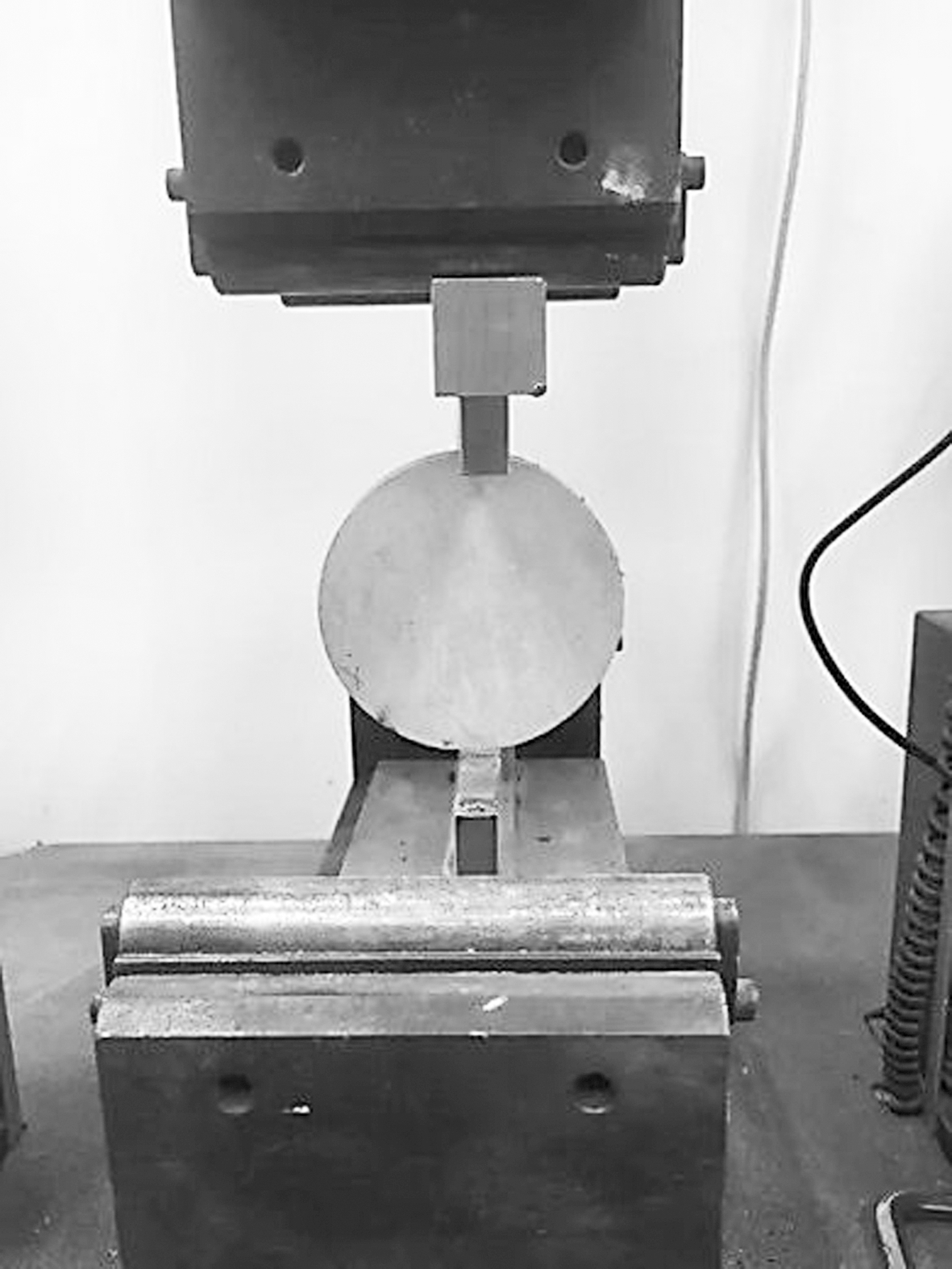
Fig.1 ECC specimen pre-cracked by the splitting test
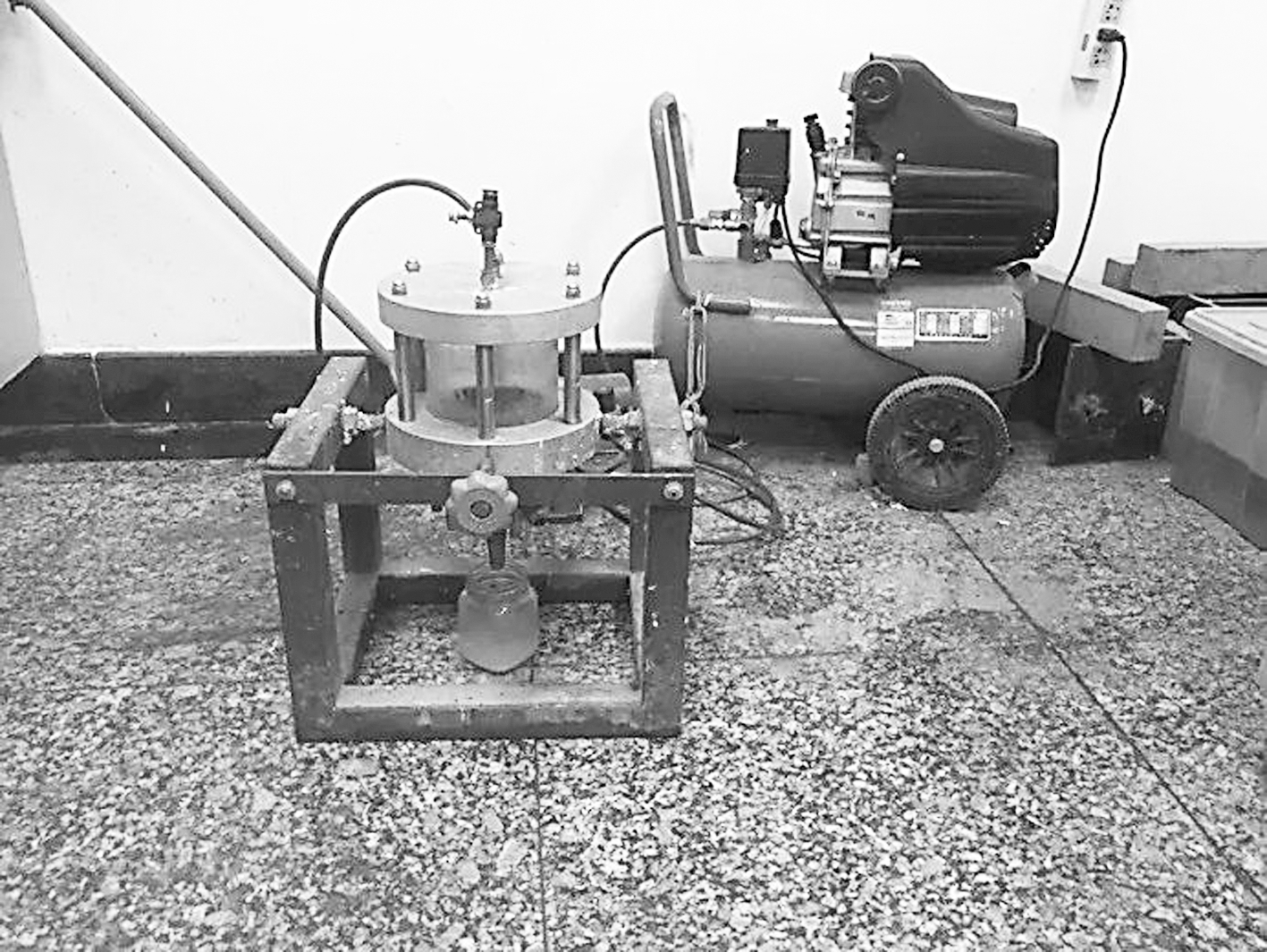
Fig.2 Rapid penetration test instrument

Fig.3 The setup of four-point bending test (unit: mm)
ESEM and DES tests were used to study the change of a crack in the self-healing process of ECC and observe the chemical components of the healing product.After being preloaded at the age of 7 d, bending specimens containing a crack width of 30 μm were cut into 5 mm×5 mm×5 mm cubic samples.In these tests, three different points were analyzed by EDS for each sample.
2 Results and Discussion
2.1 Mechanical properties of ECC
The compressive strength of ECC specimens with different SAP contents at 7, 28 and 90 d, respectively, is displayed in Tab.3.Four 75 mm×75 mm×75 mm cube specimens were used to obtain the average results.From Tab.3, as expected, the compressive strength of ECC specimens at 28 d decreases by about 13% as the SAP content increases from 0% to 4%.However, the compressive strength of ECC with 4% SAP at 28 d is still greater than 40 MPa, satisfying the demand for many infrastructure constructions.The compressive strength of ECC specimens incorporating SAP particles is lower than those of one control ECC specimen (ECC1).With the increase of SAP content, the compressive strength of ECC mixtures can be further decreased.For example, the compressive strength of ECC2 and ECC3 at 28 d reduces by 5% and 13%, respectively, compared to ECC1 at 28 d.
Tab.3 Compressive strength of ECC specimens MPa
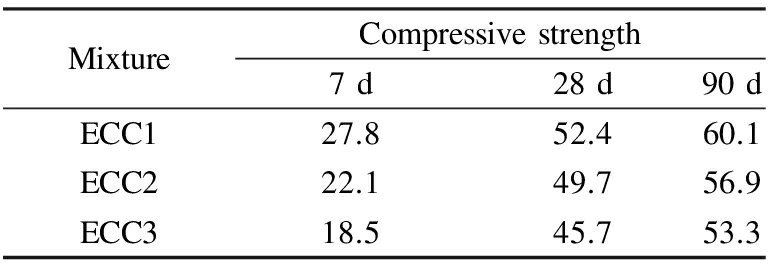
MixtureCompressivestrength7d28d90dECC127.852.460.1ECC222.149.756.9ECC318.545.753.3
The typical flexural stress-displacement curves of different ECC at 28 d are given in Fig.4.Fig.4 shows the effect of SAP particles on the flexural behavior of all, ECC specimens.The typical flexural behavior of coupon specimens after FPBT is shown in Fig.5.As seen from Fig.5(a), similar to ductile metal plates, ECC specimens have a better plastic deformation.As shown in Fig.4, SAP particles can reduce the flexural strength of ECC mixtures.Meanwhile, flexural deformation, which can reflect the ductility and toughness of the ECC material, strongly depends on the SAP content.The flexural deformation of ECC at peak load increases from 21.7 mm to 26.2 mm, with the SAP content changing from 0% to 4%.Compared to ECC1, the flexural deformation of ECC2 and ECC3 increases by 11% and 21%, respectively.Fracture energy and first cracking energy are evaluated by corresponding integral areas under the stress-displacement curve of ECC.A toughness index calculated by fracture energy and first cracking energy indicates the ECC strain-hardening degree.As listed in Tab.4, SAPs can improve the toughness index of ECC.Compared with ECC1, the toughness index of ECC2 and ECC3 increases by 23% and 66%, respectively.The above results indicate that SAP particles can act as artificial flaws to lead cracks to occur easily in the ECC matrix and help the ECC to realize pseudo strain-hardening performance[17].
It can be seen from Tab.4 that the average crack width decreases in different degrees as the SAP content increases.Meanwhile, compared to ECC1, the number of cracks in ECC2 and ECC3 shows an apparent increase.According to Refs.[6, 16-17], a smaller crack width in ECC can promote self-healing behavior and recover some of the mechanical properties.
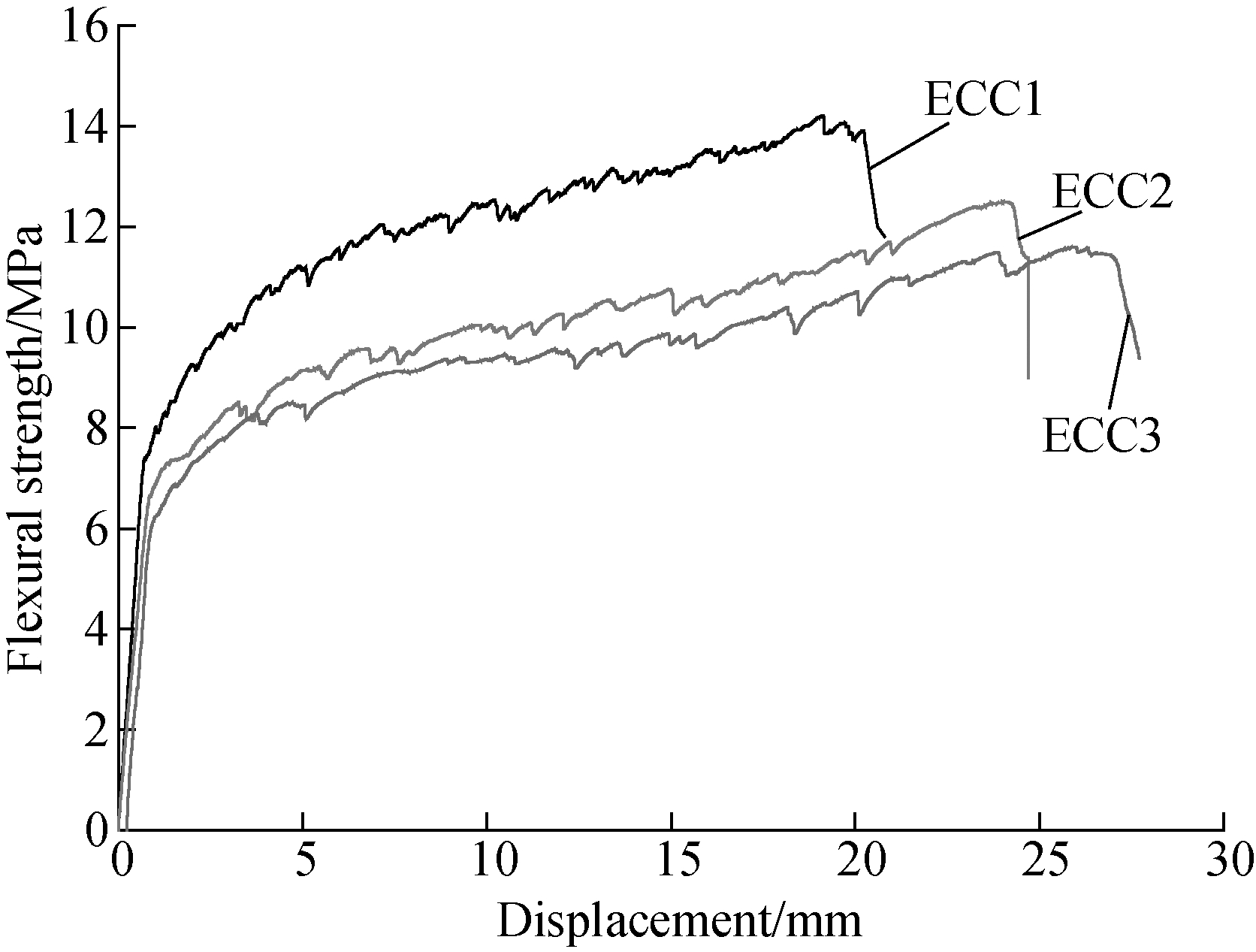
Fig.4 Typical flexural strength-displacement curves for different ECC

(a)

(b)
Fig.5 Response of coupon specimens after FPBT.(a)Bended specimen;(b)Multiple cracks
Tab.4 Mechanical properties of ECC mixtures at 28 d

MechanicalpropertiesECC1ECC2ECC3Flexuralstrength/MPa14.412.511.4Deformation/mm21.724.126.2Firstcrackingenergy/J0.1140.0970.080Fractureenergy/J4.44.75.2Toughnessindex394865Flexuralstiffness/(MPa·mm-1)14.512.99.5Crackwidth/μmMin101010Max807070Ave494235Numberofcracks526482Crackspacing/mm2.91.40.9
2.2 Decrease of water permeability by self-healing
The change of water permeability with the number of curing cycles is shown in Fig.6.The relative permeability values on the y-axis represent the weight percentage of the permeated water from the cracks of the specimen after self-healing.The relative permeability is 1, indicating that the pre-cracked specimen has undergone no healing.
As seen from Fig.6(a), the relative permeability of specimens under CR1 was faster than that of CR2 approaching 0.It can be summarized that high/low relative humidity curing regimes may be more advantageous to crack self-healing.
As seen from Fig.6(b), the water permeability decrease rate of ECC2 and ECC3 is faster than that of ECC1, with ECC3 being the fastest of all mixtures.It can be explained by the crack width of ECC3 being smaller than that of ECC1, which contributes to self-healing.Moreover, higher swollen SAP content can seal the crack and release water to achieve self-healing.
2.3 Recovery of mechanical properties by self-healing
The flexural strength of mixtures ECC1, ECC2 and ECC3 under different curing conditions and pre-loading displacements is compared in Fig.7.It should be noted that the variations of the flexural strength of ECC1 is very small, whereas that of mixtures containing SAP particles has a great fluctuation for different curing conditions and pre-loading displacements.The flexural strength of ECC2 and ECC3 from CR1 and CR2 curing is larger than that of the reference (no pre-cracked)for the preloading displacement of 3, 6 and 9 mm, due to the continuous hydration of unhydrated cementitious material with the help of SAP particles.

(a)

(b)
Fig.6 Changes of water permeability with number of environmental conditioning cycles.(a)ECC1 for different exposure regimes; (b)Different ECC mixtures under CR1
The effect of self-healing can also be seen from the level of flexural stiffness retained after CR1, CR2 and CR3 curing compared with the reference sample, as shown in Fig.8.The flexural stiffness is defined as the scant of the initial slope of the flexural strength-displacement curve when the flexural strength is between 1 and 5 MPa.The flexural stiffness of ECC1 in CR3 indicates the stiffness of the relatively soft bridging fibers.As seen from Fig.8(a), all relative stiffness values in CR1 and CR2 are larger than those in CR3 due to self-healing under these conditions, but the degree of recovery is relatively low.
Figs.8(b)and (c)show the relative flexural stiffness of healed ECC2 and ECC3 specimens to the reference specimens (no pre-cracked).As seen from Figs.8(b)and (c), the level of relative flexural stiffness retained after CR1, CR2 and CR3 increases with the content of SAP particles in ECC mixtures due to the presence of SAPs in cementitious materials for continuous hydration.It may be also explained that SAPs manage to take moisture out of a humid environment and provide it to the cemetitious matrix for crack self-healing.The flexural stiffness in CR1 curing is much higher compared with that in CR2 and CR3 curing .This curing condition can effectively help SAPs promote the interaction of water, CO2 and remaining unhydrated cement particles in ECC materials (including matrix and fiber-matrix interface), therefore resulting in the best recovery of flexural stiffness.Moreover, the greater the content of SAP particles, the better the recovery from flexural stiffness.The general trend shows that specimens containing a higher SAPs content, with lower pre-load levels, tend to have higher flexural stiffness recovery.This is because a larger number of cracks and greater crack width at higher pre-load levels can lead to reduction of flexural stiffness recovery.

(a)
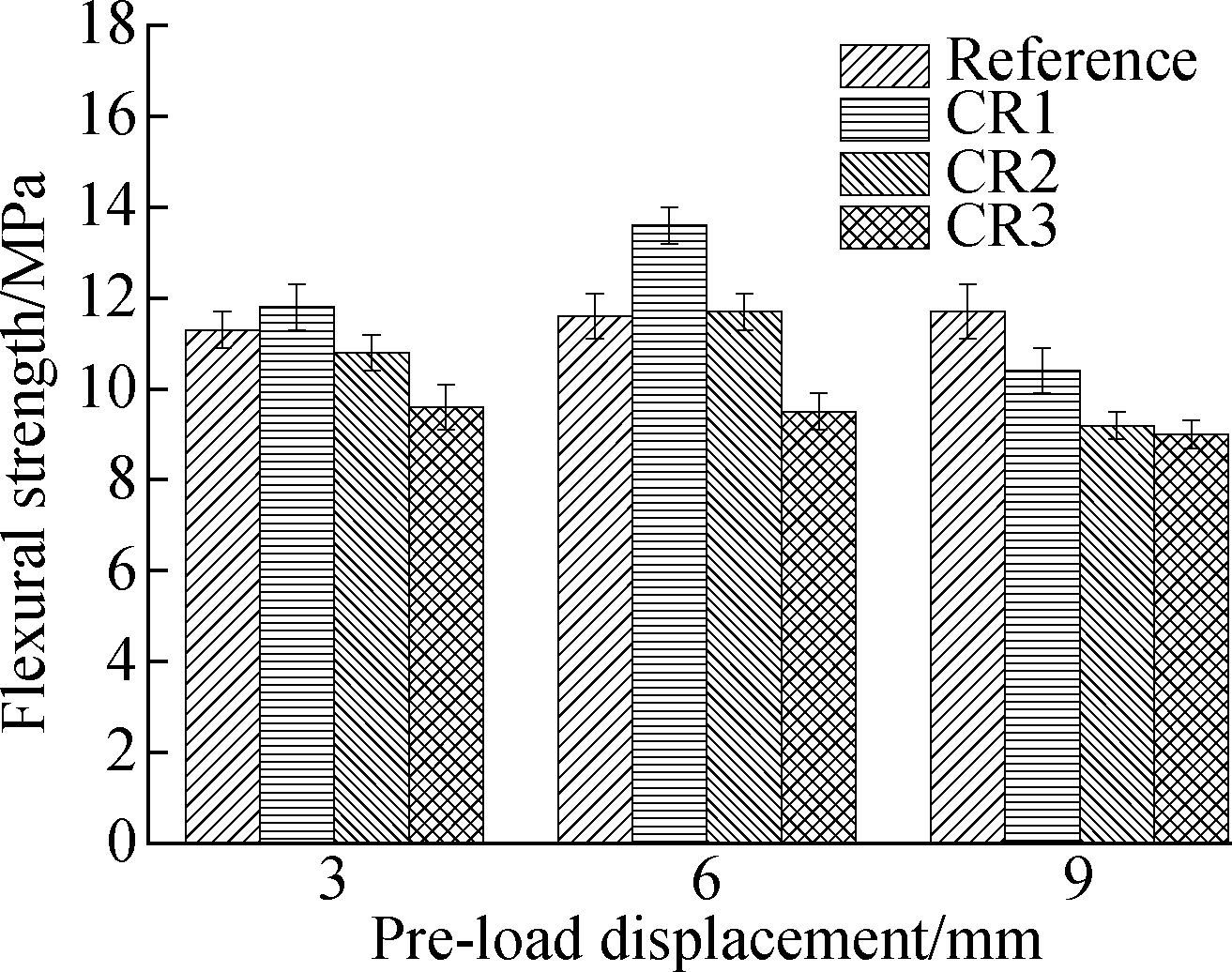
(b)
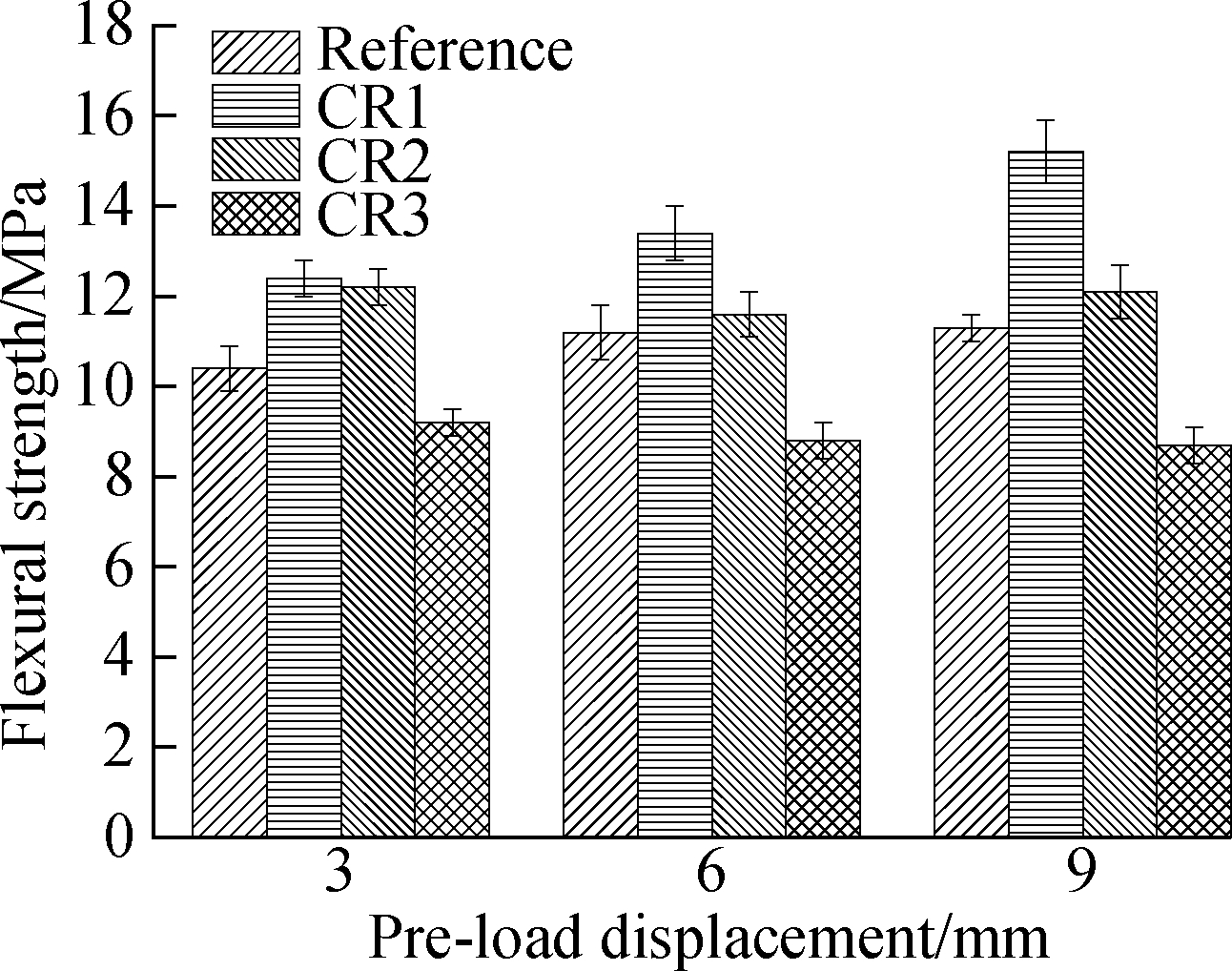
(c)
Fig.7 Comparison of flexural strength of the mixture for different curing conditions and pre-loading displacements: (a)ECC1; (b)ECC2; (c)ECC3
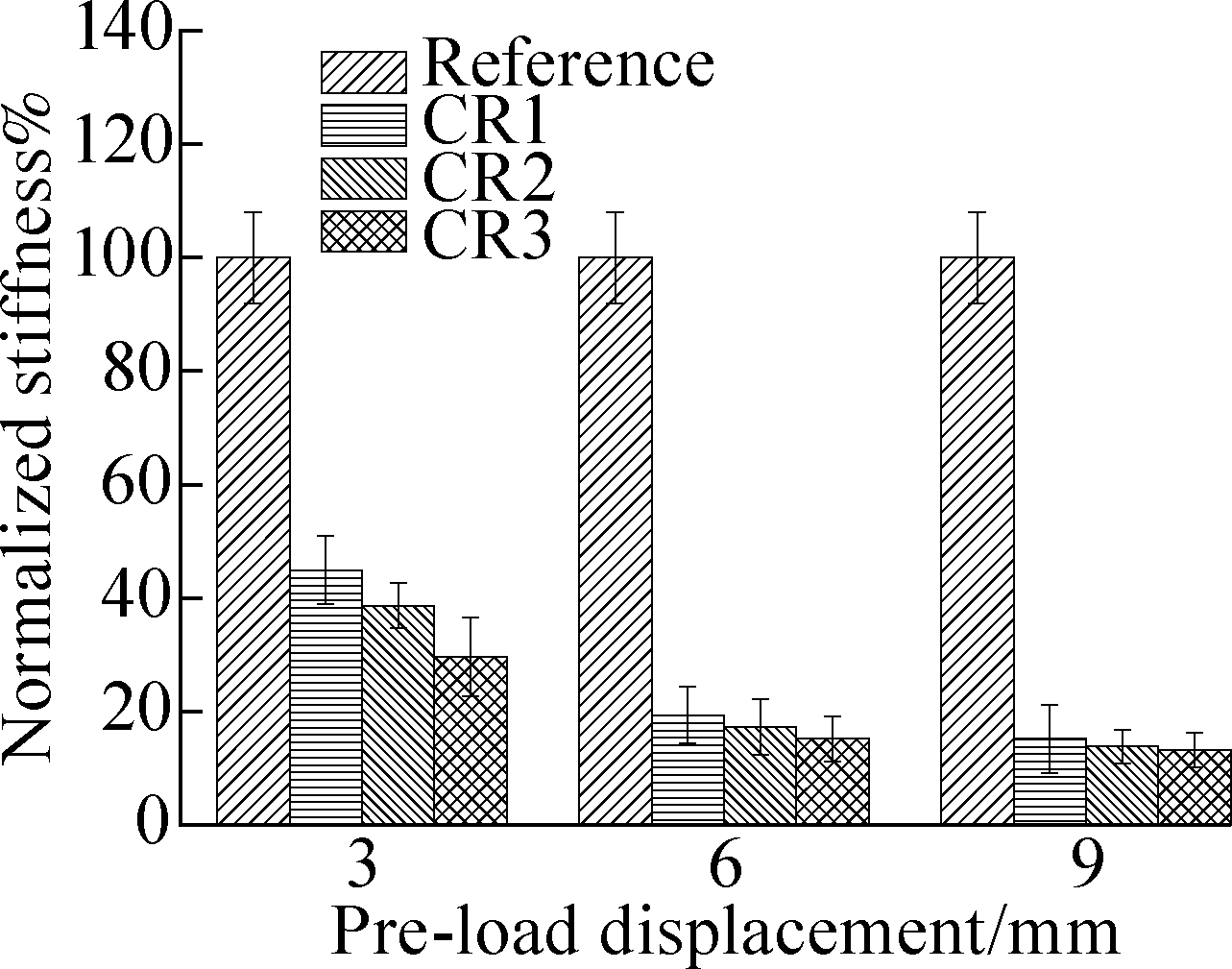
(a)
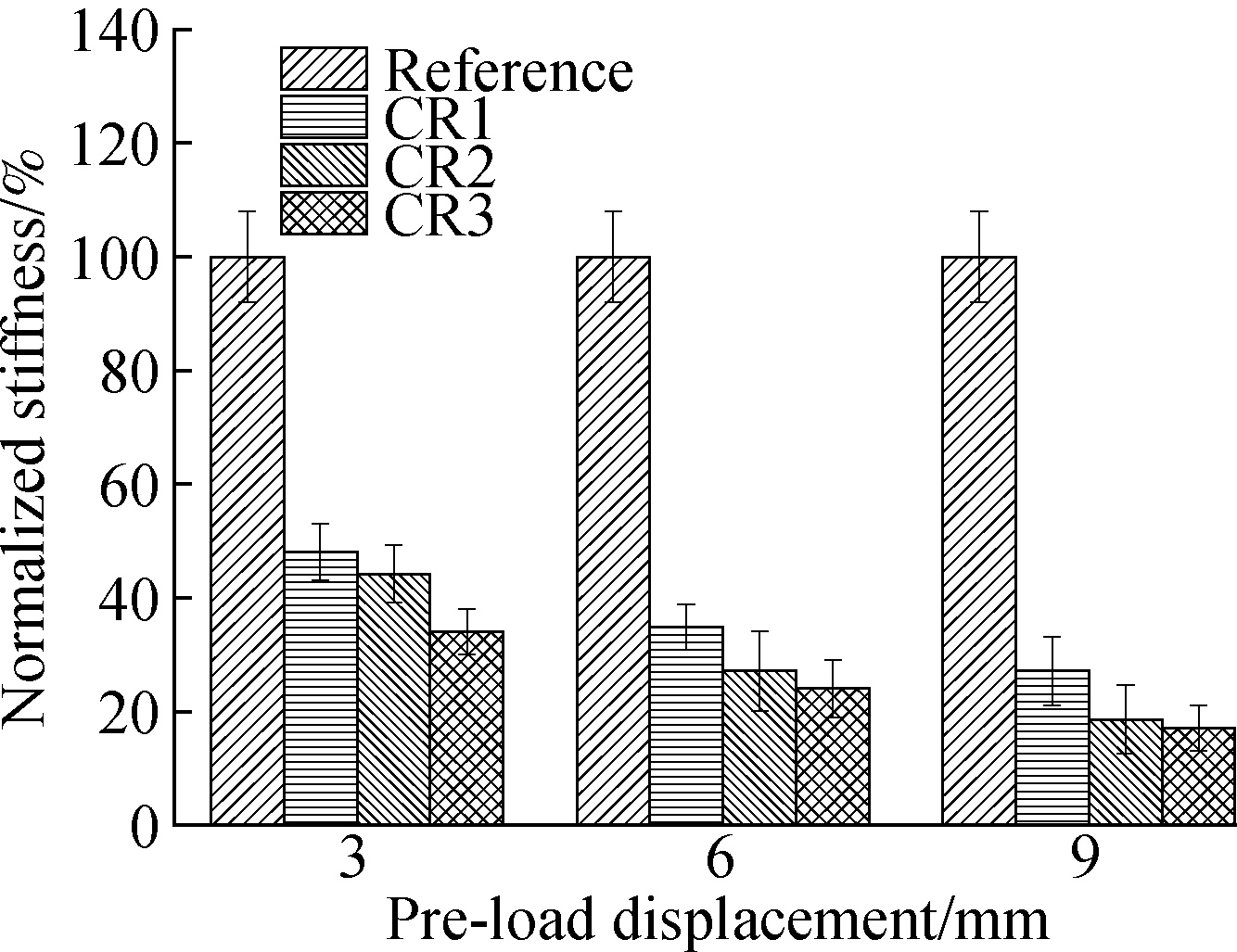
(b)
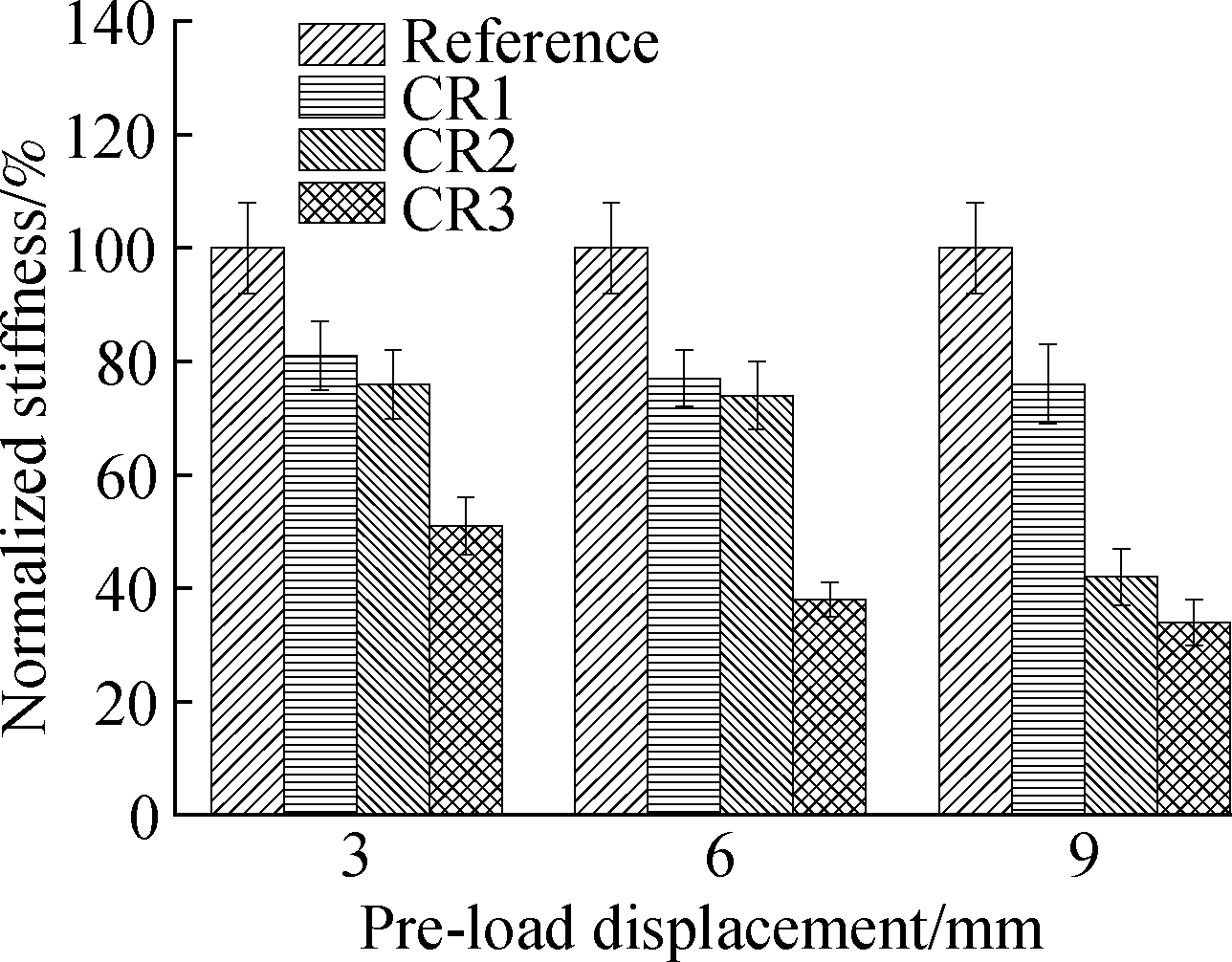
(c)
Fig.8 Comparison of normalized stiffness of the mixture for different curing conditions and pre-loading displacements.(a)ECC1; (b)ECC2; (c)ECC3
The influence of pre-loading times on self-healing for the mechanical properties of ECC is shown in Tab.5 and Fig.9.Tab.5 presents four-point flexural test results after ten self-healing cycles from specimens subjected to pre-loaded deformation of 3, 6 and 9 mm, respectively, at the age of 7 and 28 d.It can be seen from Fig.9 that no apparent self-healing occurs in CR3.Similar to Ref.[19], the results in CR3 were considered as no self-healing.As seen from Tab.5, self-healing behavior has a slight effect on the flexural strength of ECC when pre-loaded at 7 d.However, when pre-loaded at 28 d, the flexural strength of specimens containing 4% content of SAPs (ECC3)after self-healing is larger than the case without healing.
The deflection (deformation)capacity is a major concern for ECC material since its structural applications mainly require high ductility.Fig.9 shows the influence of different pre-loading time and pre-loading levels on the normalized deflection capacity of different mixtures.The normalized deflection capacity is defined as the percentage of the displacement of the healed or non-healed specimens to that of reference case (no pre-cracked).As seen from Fig.9(a), when pre-loaded at 7 d, the remaining deflection capacity of pre-loaded ECC1 specimens (without SAPs)after self-healing and non-self-healing are only about 52% to 74% and 27% to 71%, respectively.A similar deflection capacity is retained in the ECC1 specimens when pre-loaded at 28 d, which may be related to a larger proportion of elastic fiber stretch within the pre-loading deformation since fiber/matrix interface micromechanical performance is enhanced with age, or there is not enough self-healing products inside the crack after self-healing.These results indicate that the ECC specimens without SAPs cannot achieve complete self-healing.

(a)
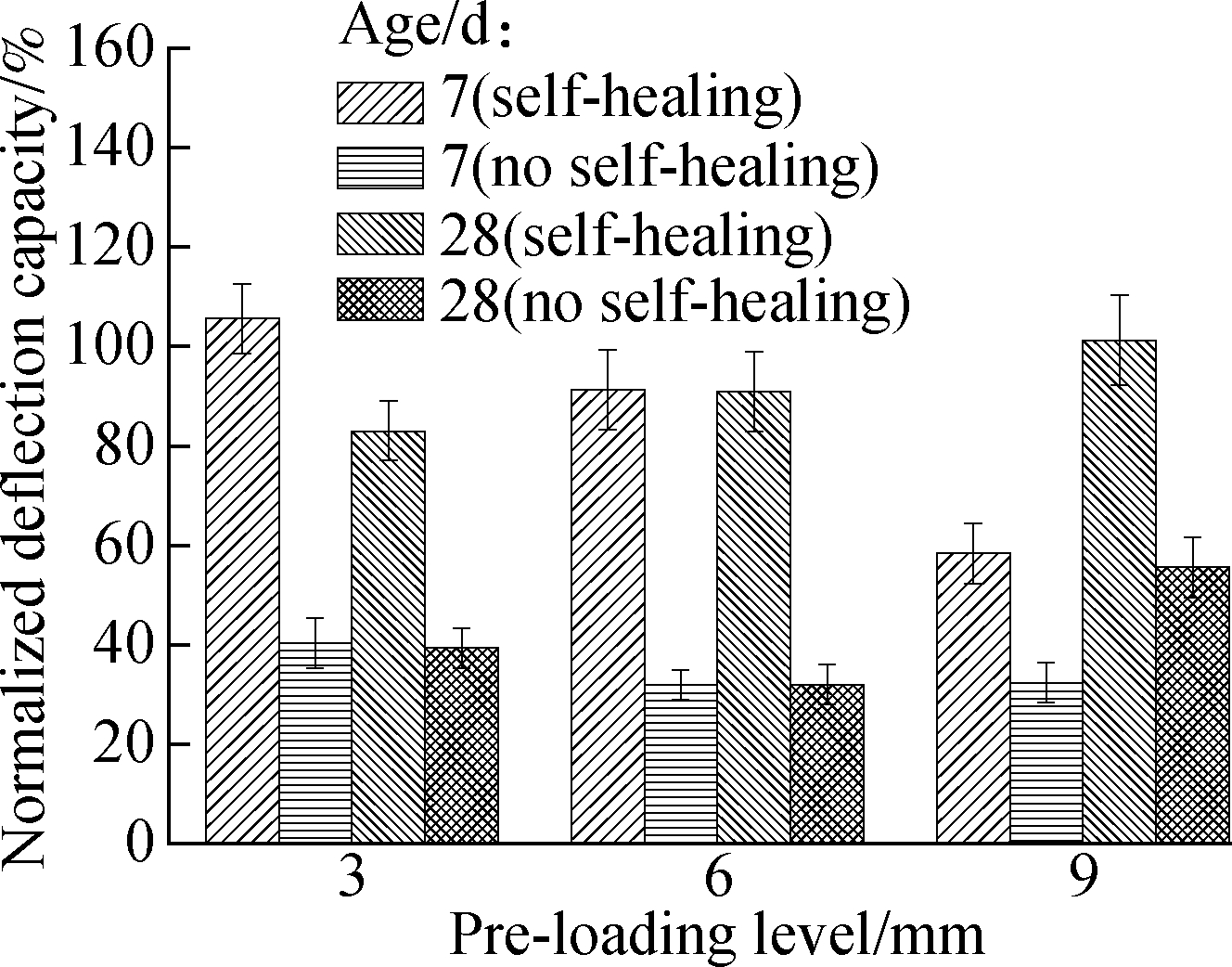
(b)
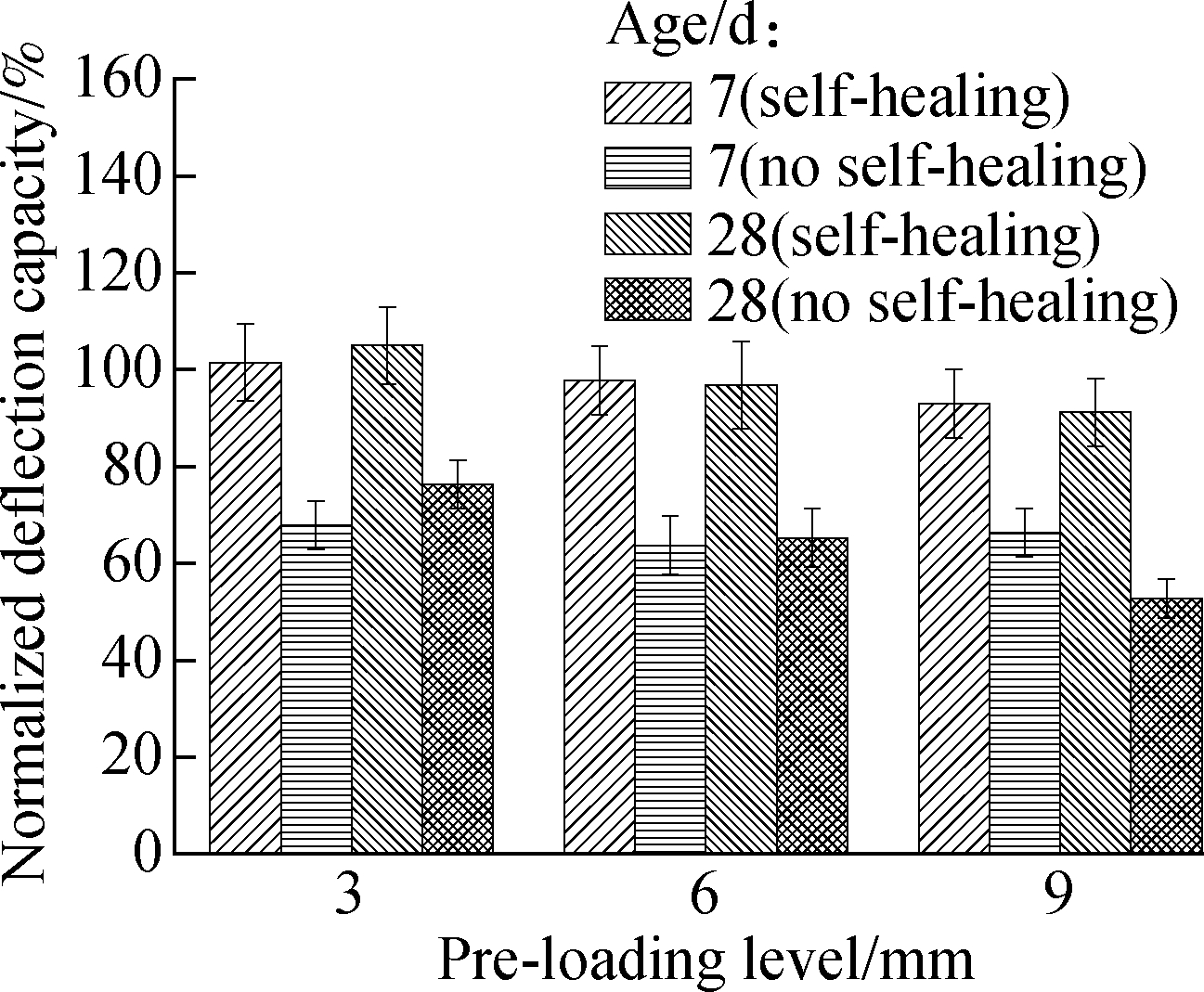
(c)
Fig.9 Influence of different pre-loading time and pre-loading level on normalized deflection capacity of mixture.(a)ECC1; (b)ECC2; (c)ECC3
Figs.9 (b)and (c)show the comparison of the normalized deflection capacity of mixture ECC2 and ECC3 for different pre-loading times and pre-loading levels.As seen from Figs.9 (b)and (c), a larger deflection capacity is retained in the specimens with SAPs after self-healing when pre-loaded at 7 and 28 d compared with ECC1 specimens (without SAPs).It may be explained that SAPs can absorb fluids from the surroundings and swell and block cracks, which contributes to the internal healing/curing.Meanwhile, increasing the content of SAPs can enhance healing due to more internal curing.Ma et al.[19] found that the deflection capacity recovered best after self-healing at 7 d and it was minimal when pre-loaded at 28 d.However, it can be seen from Fig.9 that the samples containing higher content SAPs after self-healing when pre-loaded at 7 and 28 d can both reach about 93% to 102% and 91% to 105% of the deflection capacity of the reference samples.The recovery level is significantly higher than that of ECC1 in Fig.9(a).These results indicate that good self-healing behavior of ECC materials has been achieved at an early age, thus improving the durability of concrete.
Tab.5 Flexural properties of ECC specimens with different pre-loading times
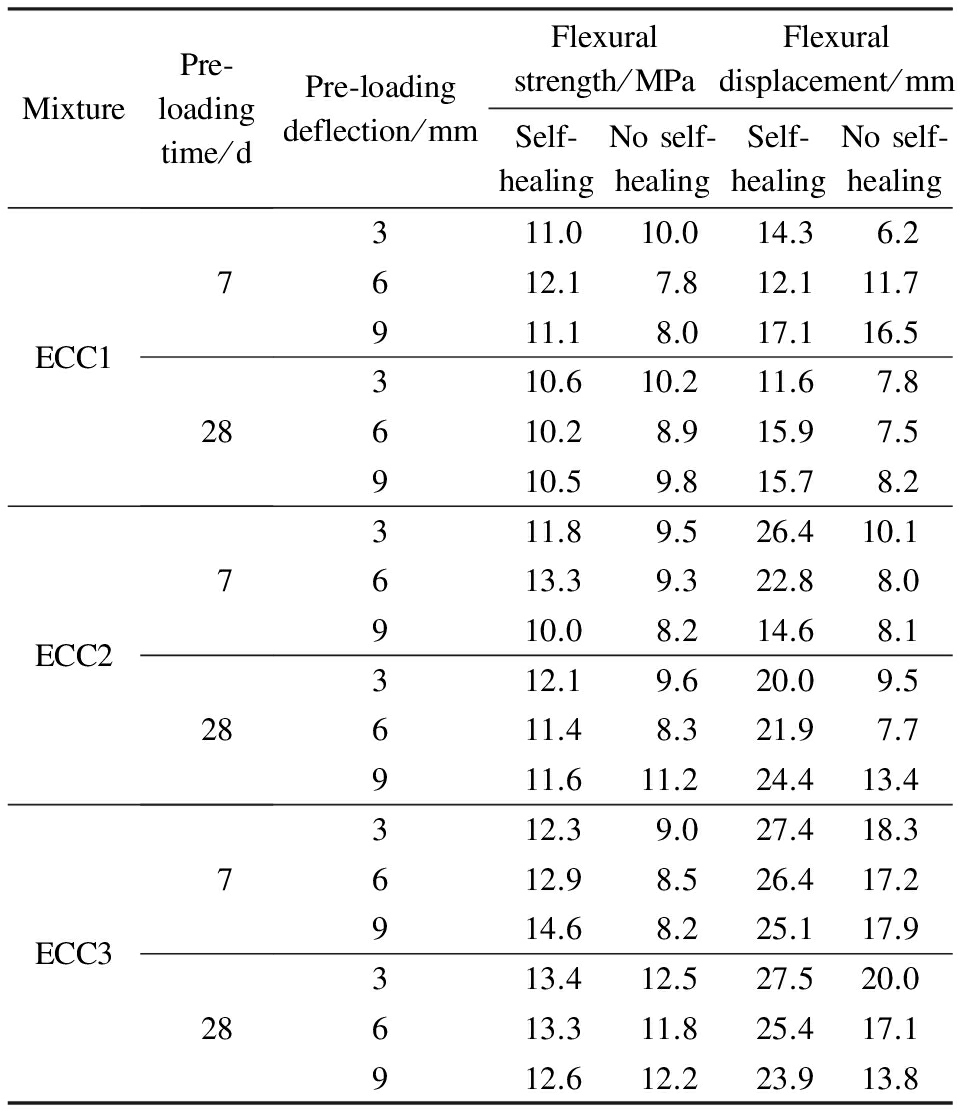
MixturePre⁃loadingtime/dPre⁃loadingdeflection/mmFlexuralstrength/MPaFlexuraldisplacement/mmSelf⁃healingNoself⁃healingSelf⁃healingNoself⁃healingECC1728311.010.014.36.2612.17.812.111.7911.18.017.116.5310.610.211.67.8610.28.915.97.5910.59.815.78.2ECC2728311.89.526.410.1613.39.322.88.0910.08.214.68.1312.19.620.09.5611.48.321.97.7911.611.224.413.4ECC3728312.39.027.418.3612.98.526.417.2914.68.225.117.9313.412.527.520.0613.311.825.417.1912.612.223.913.8
Fig.10 shows the normalized stiffness of healed/non-healed ECC specimens with respect to that of the reference case (condition A)for different pre-loading times.As seen from these figures, the stiffness of pre-loaded specimens without self-healing is always smaller than that of the healed ones, but the gap decreases with the increase of pre-cracking level.Furthermore, Fig.10 shows that there are stable increase stiffness gains when comparing healed and non-healed specimens with the increase of the content of SAPs.In comparison, due to crack self-healing by the release of water from SAP particles, a significant recovery of stiffness has been accomplished in ECC3 specimens, which were pre-loaded at 7 d and then cured in CR1 for 10 cycles.In the case of pre-loading to the deformation of 3, 6 and 9 mm, the stiffness of ECC3 can also recover 80%.When pre-loading to the deformation of 3 mm at 28 d, the flexural stiffness recovery level is 60%, beyond the case of specimens without SAPs.
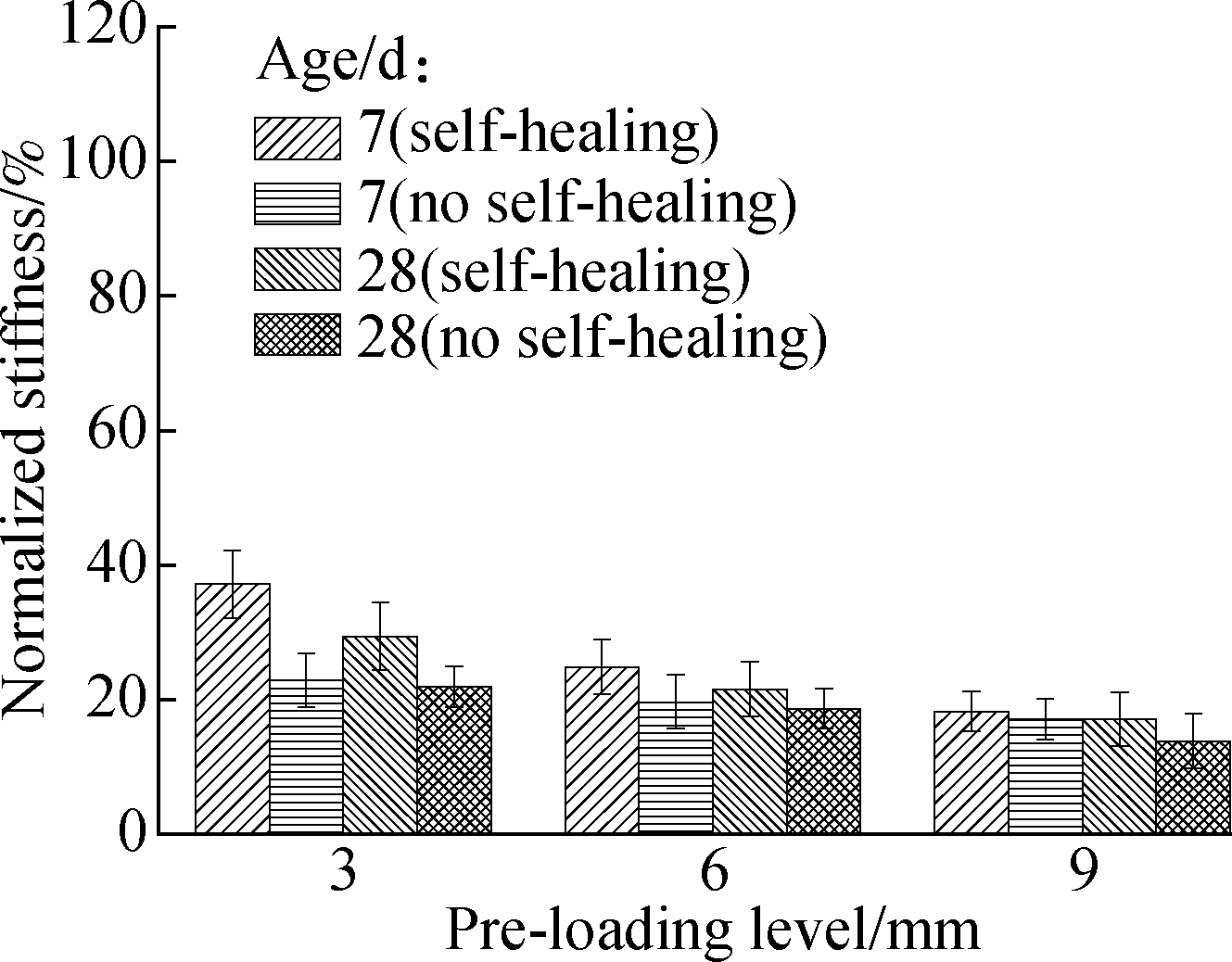
(a)
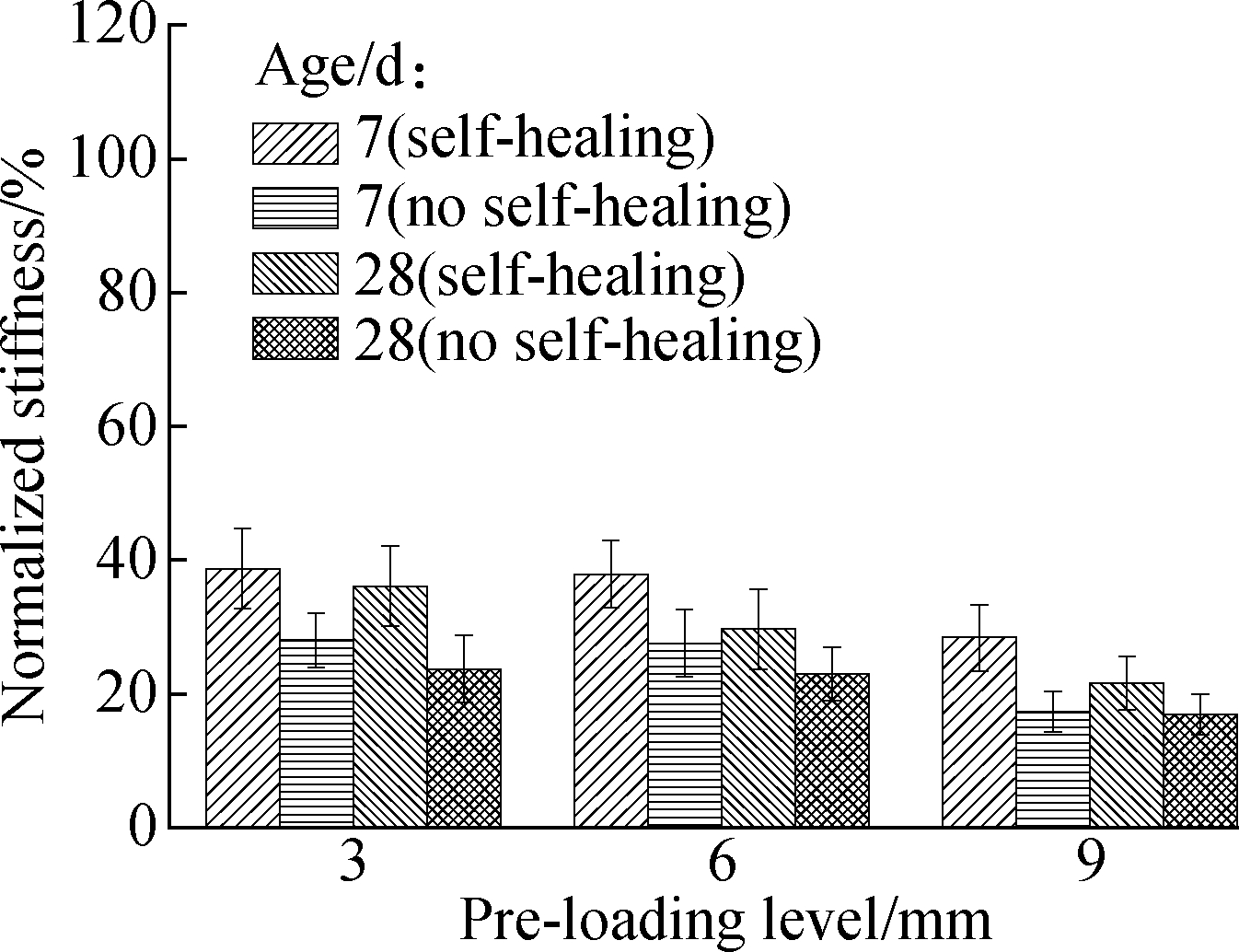
(b)
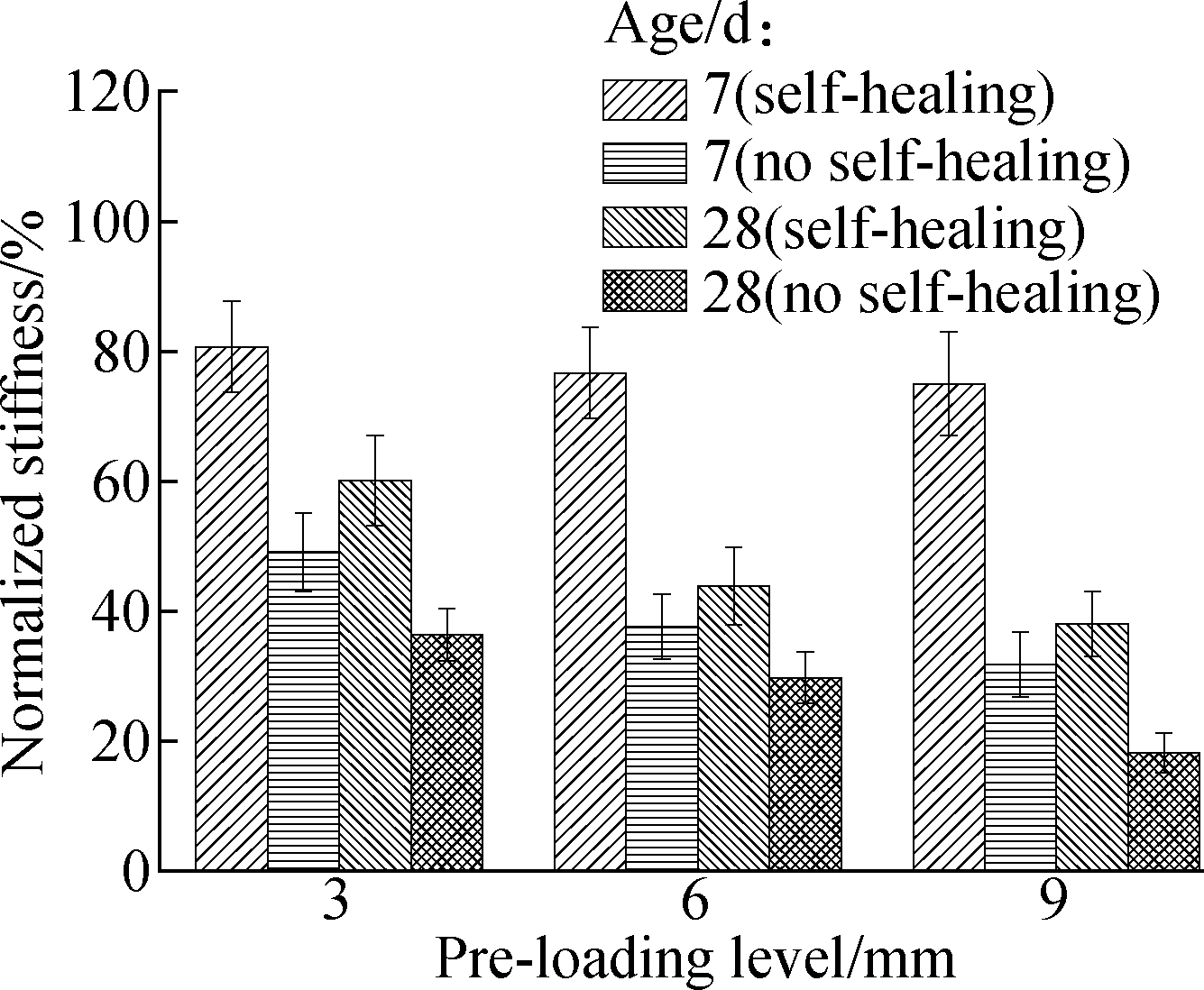
(c)
Fig.10 Influence of different pre-loading time and pre-loading deflection on flexural stiffness of healed/non healed specimens.(a)ECC1; (b)ECC2; (c)ECC3
2.4 Microstructure of self-healed ECC
From Fig.11, it can be clearly seen that a large number of self-healing products displays along crack lines.As seen in Fig.12(b), an abundant of stone-like healed products were filled in all cracks of ECC1 after 3 cycles.Especially in ECC3, more self-healing products were precipitated in cracks, and the cracks were almost healed completely (see Fig.12(e)).However, this completely healed phenomenon occurring in ECC1 needs ten curing cycles.The microscopical observations indicate that self-healing of ECC mainly occurs in the first three CR1 cycles, in which the cracks can be healed up to about 80% even 100%.All indications show that SAP particles can accelerate the self-healing of ECC materials.
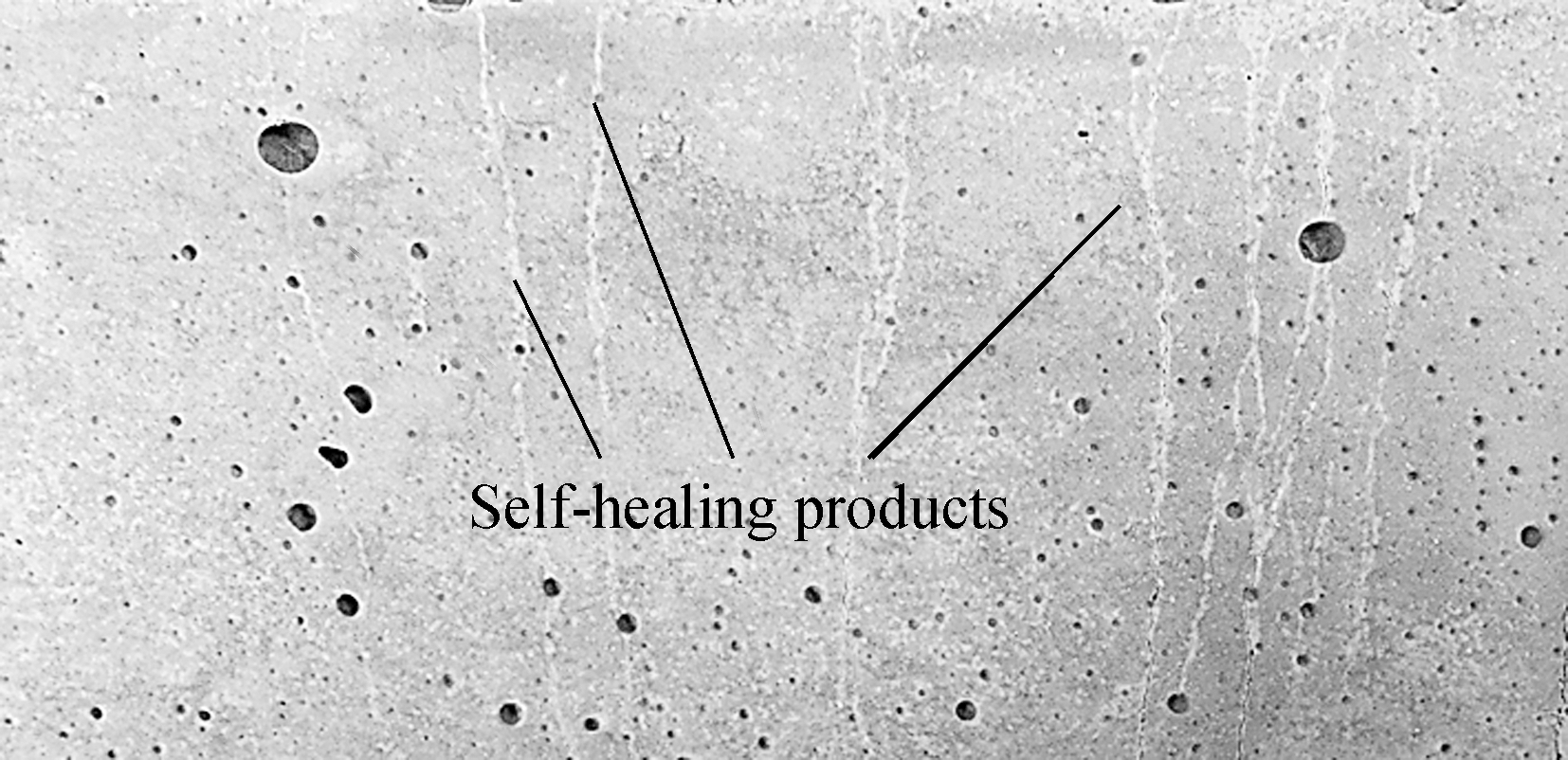
Fig.11 Self-healing of crack-damaged ECC after ten cycles under CR1
Fig.13 and Tab.6 show the ESEM close-up view and EDS analysis results of products in the self-healed cracks of ECC specimens.Based on Tab.6, the mass ratio of Ca to Si increases rapidly with the increase of self-healing cycles.It can be explained that the C-S-H is the main healing product due to its continuous hydration.The change of mass ratio of O to Ca and C to Ca indicates that the CaCO3 content increases in the healed products of cracks.
3 Conclusions
1)Incorporating SAP particles as pre-existing flaws can improve the flexural deformation capacity of ECC specimens.The flexural deformation of specimens in ECC2 and ECC3 at 28 d increases by 11% and 21%, respectively, compared to ECC1.Meanwhile, SAP particles reduce the crack width of ECC specimens, which can improve the durability of ECC.
2)The water permeability of pre-cracked specimens decreases rapidly after 3 or 4 cycles due to self-healing.Compared with ECC1, faster self-healing behaviors were observed in the specimens of ECC3 cured in high/low humidity cycles, because swollen SAP particles release water and help the formation of CaCO3 with abundant availability of CO2 in the air.
3)Different degrees of recovery of mechanical properties due to self-healing were found in this study, including flexural strength, flexural stiffness and deformation capacity.Similar to water permeability, a better recovery of mechanical properties after self-healing was achieved when the SAP content was 4% (ECC3).The lower pre-damaged level it makes, the better mechanical recovery it achieves.
4)The self-healing process of ECC mainly occurs in first three CR1 cycles, and the self-healing product is a mixed Ca(OH)2/CaCO3, with CaCO3 being a major component at a later age due to the participation of CO2 in the air.
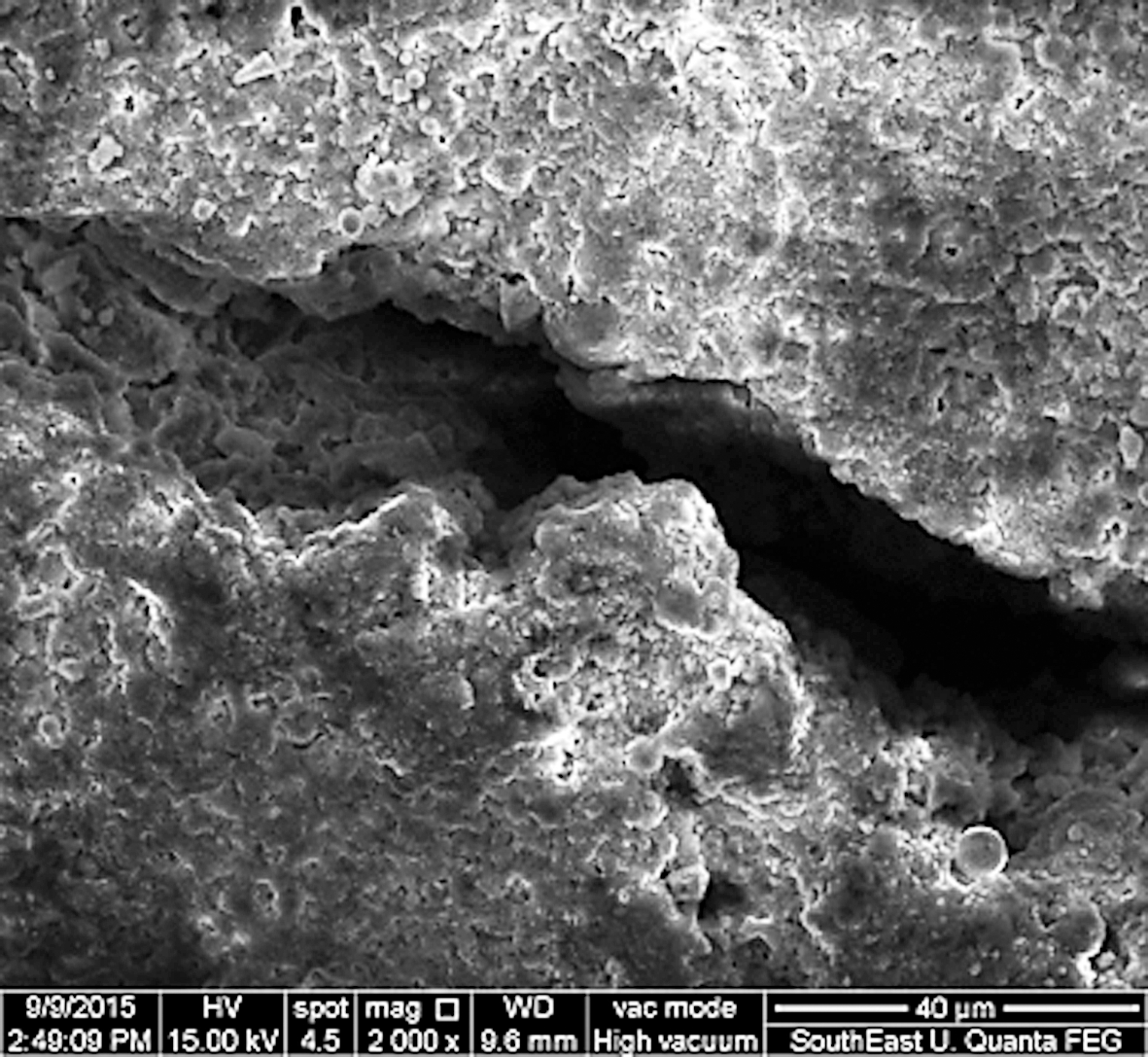
(a)

(b)

(c)
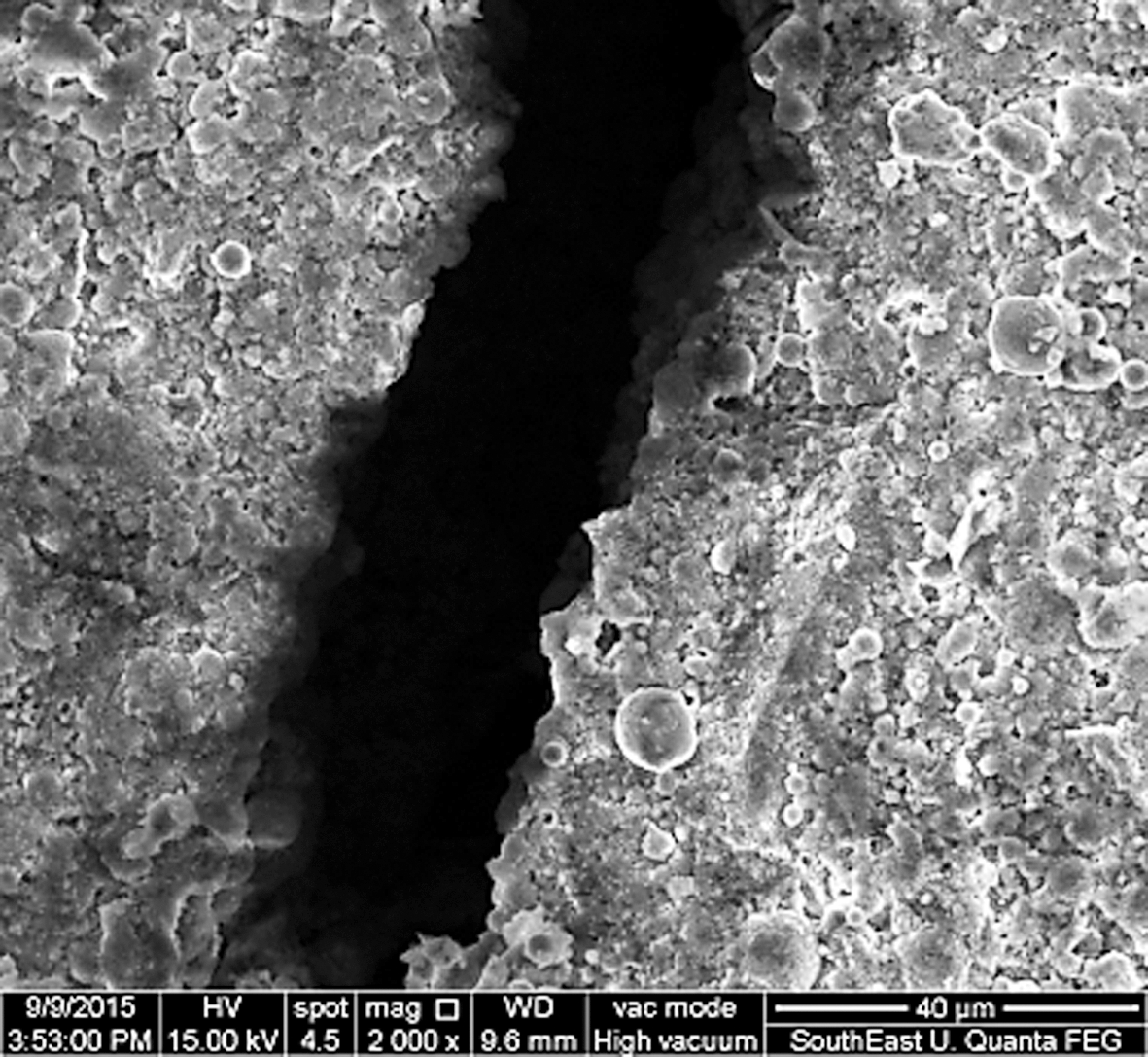
(d)
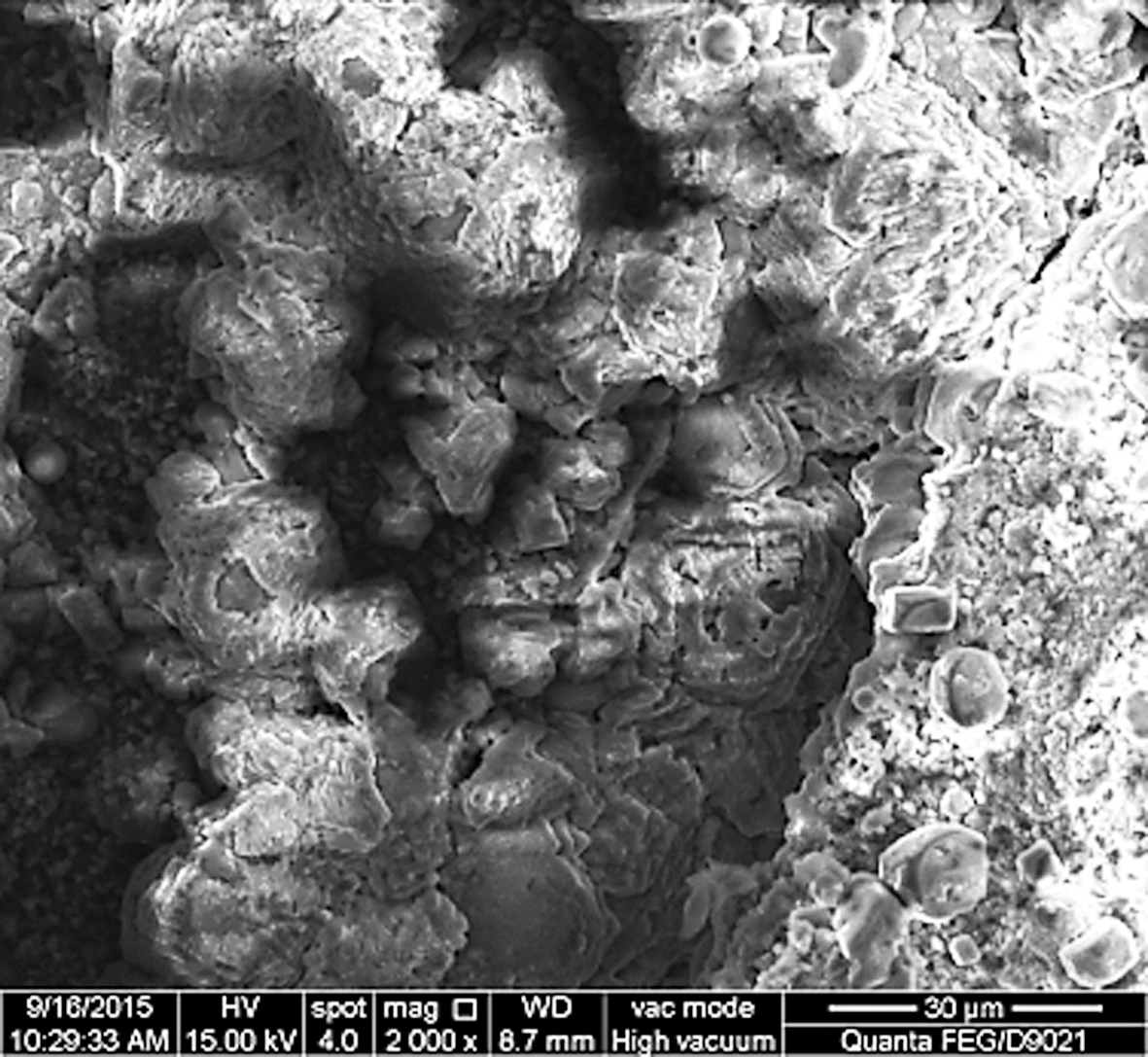
(e)
Fig.12 Microscopical observation of self-healing process for ECC with 30 μm crack width.(a)0 cycle of ECC1; (b)3 cycles of ECC1; (c)10 cycles of ECC1; (d)0 cycle of ECC3; (e)3 cycles of ECC3
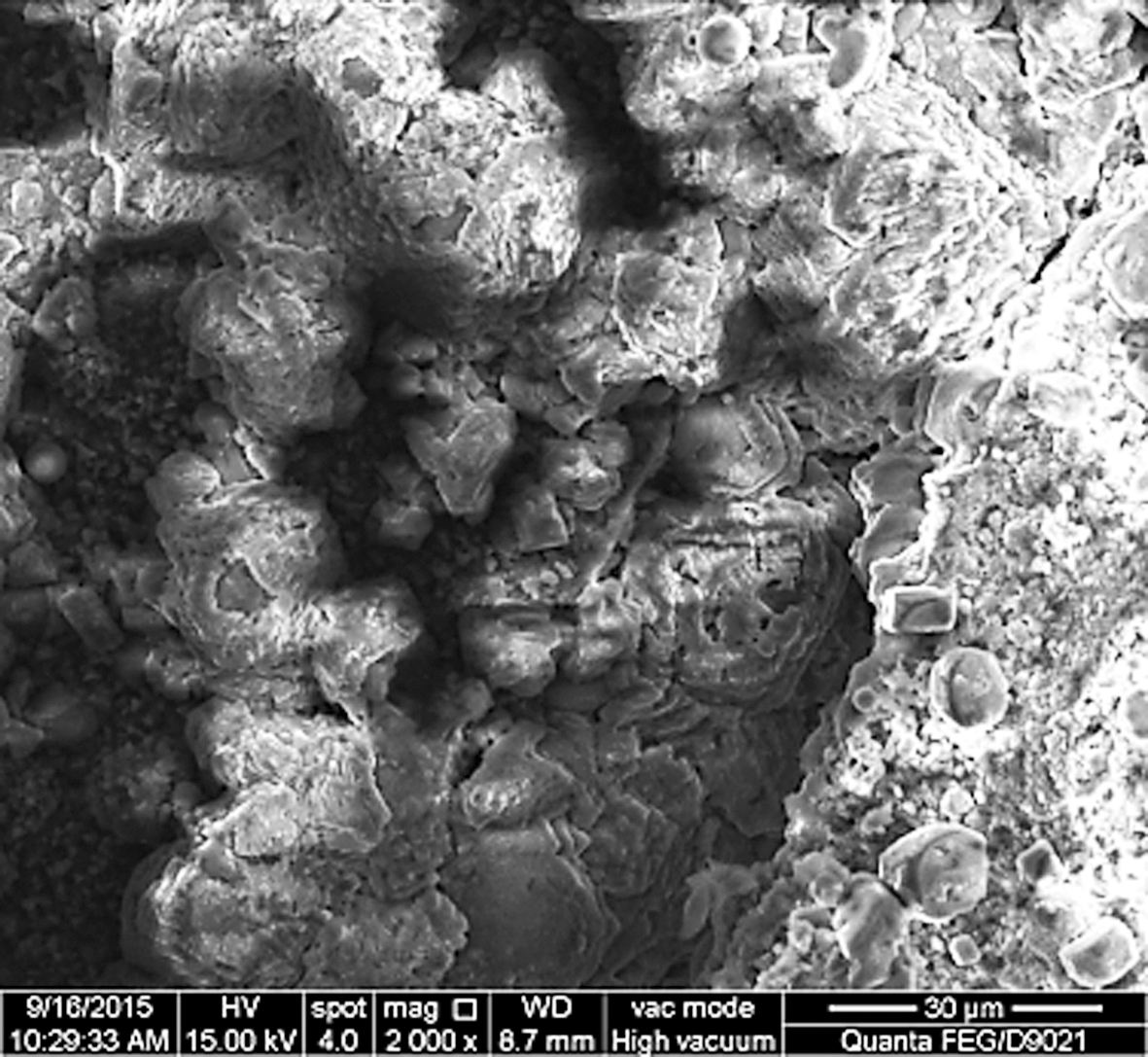
(a)
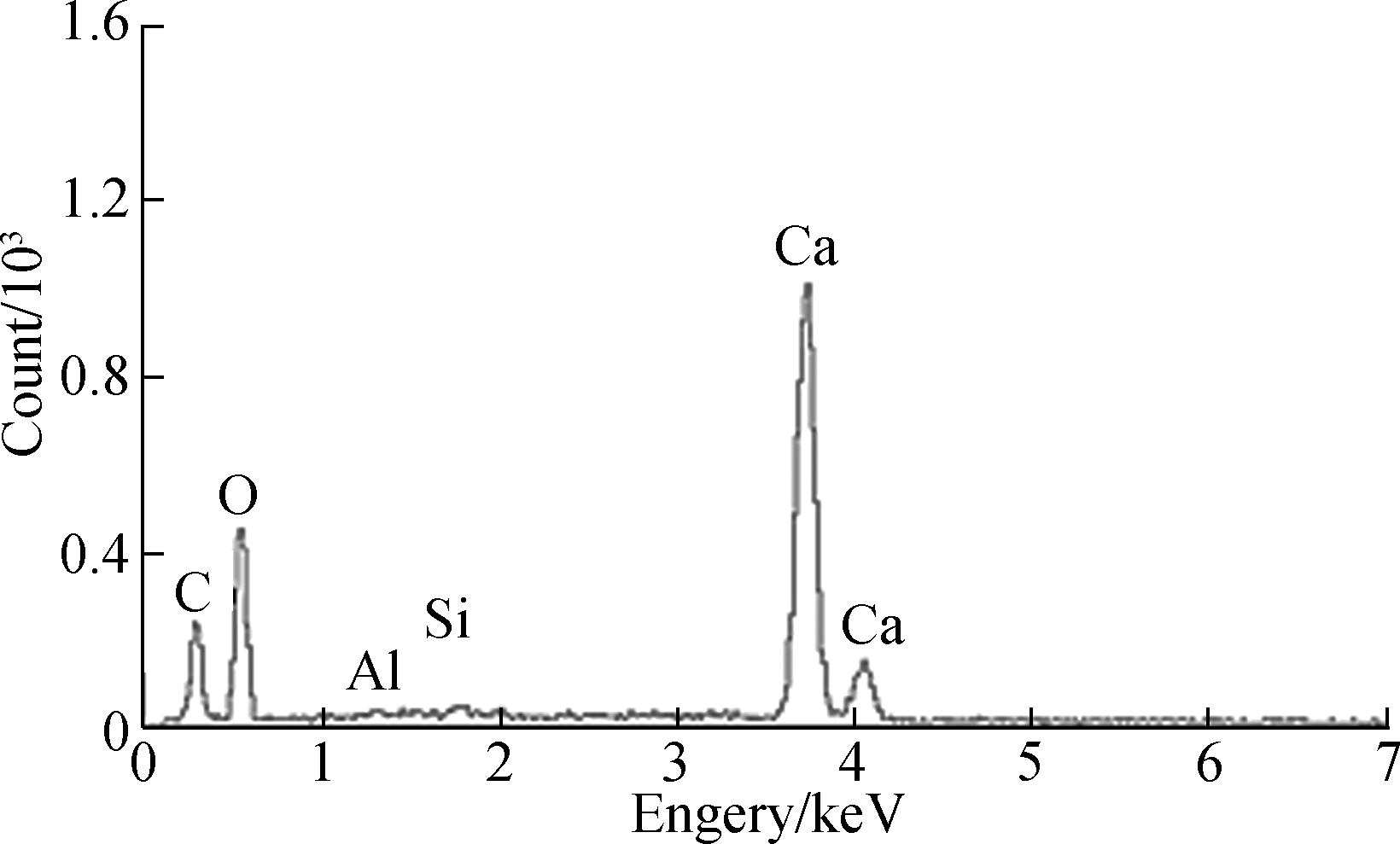
(b)
Fig.13 ESEM micrograph and EDS analysis of self-healing products for ECC.(a)ESEM; (b)EDS
Tab.6 EDS analysis results for self-healing products of ECC

MixtureSelf⁃healingcyclesAtompercent/%COSiCaWeightratioofCatoSiWeightratioofOtoCaWeightratioofCtoCaECC103741980.95.14.6328502199.52.61.51034480.517342.82.0ECC203246891.15.13.632346129291.60.81029460.424601.91.2ECC3027491290.75.43.0330502178.52.91.8
References
[1]Wang K, Jansen D C, Shah S P, et al.Permeability study of cracked concrete[J].Cement and Concrete Research, 1997, 27(3): 381-393.DOI:10.1016/s0008-8846(97)00031-8.
[2]Edvardsen C.Water permeability and autogenous healing of cracks in concrete [J].Materials Journal, 1999, 96(4):448-454.
[3]Granger S, Loukili A, Pijaudier-Cabot G, et al.Experimental characterization of the self-healing of cracks in an ultra high performance cementitious material: Mechanical tests and acoustic emission analysis[J].Cement and Concrete Research, 2007, 37(4): 519-527.DOI:10.1016/j.cemconres.2006.12.005.
[4]Homma D, Mihashi H, Nishiwaki T.Self-healing capability of fibre reinforced cementitious composites[J].Journal of Advanced Concrete Technology, 2009, 7(2): 217-228.
[5]Heide N T.Crack healing in hydrating concrete[D].Delft, the Netherlands: Delft University of Technology, 2005.
[6]Van Tittelboom K, Gruyaert E, Rahier H, et al.Influence of mix composition on the extent of autogenous crack healing by continued hydration or calcium carbonate formation[J].Construction and Building Materials, 2012, 37: 349-359.DOI:10.1016/j.conbuildmat.2012.07.026.
[7]Yang Y, Lepech M D, Yang E H, et al.Autogenous healing of engineered cementitious composites under wet-dry cycles[J].Cement and Concrete Research, 2009, 39(5): 382-390.DOI:10.1016/j.cemconres.2009.01.013.
[8]Cowie J, Glasser F P.The reaction between cement and natural waters containing dissolved carbon dioxide[J].Advances in Cement Research, 1992, 4(15): 119-134.DOI:10.1680/adcr.1992.4.15.119.
[9]Snoeck D, van Tittelboom K, Steuperaert S, et al.Self-healing cementitious materials by the combination of microfibres and superabsorbent polymers[J].Journal of Intelligent Material Systems and Structures, 2014, 25(1):13-24.
[10]Yang E-H.Designing added functions in engineered cementitious composites[D].Ann Arbor, MI , USA: Department of Civil Engineering, University of Michigan, 2008.
[11]Snoeck D, de Belie N.Mechanical and self-healing properties of cementitious composites reinforced with flax and cottonised flax, and compared with polyvinyl alcohol fibres[J].Biosystems Engineering, 2012, 111(4): 325-335.DOI:10.1016/j.biosystemseng.2011.12.005.
[12]Li V C, Wang S, Wu C.Tensile strain-hardening behavior of polyvinyl alcohol engineered cementitious composite (PVA-ECC)[J].ACI Materials Journal, 2001, 98: 483-492.
[13]Qian S Z, Zhou J, Schlangen E.Influence of curing condition and precracking time on the self-healing behavior of engineered cementitious composites[J].Cement and Concrete Composites, 2010, 32(9): 686-693.DOI:10.1016/j.cemconcomp.2010.07.015.
[14]Snoeck D, Steuperaert S, van Tittelboom K, et al.Visualization of water penetration in cementitious materials with superabsorbent polymers by means of neutron radiography[J].Cement and Concrete Research, 2012, 42 (8): 1113-1121.DOI:10.1016/j.cemconres.2012.05.005.
[15]Reinhardt H W, Mönnig S.Basic concepts for a model of different internal water sources[C]//RILEM—JCI Seminar on Concrete Durability and Service Life Planning.RILEM Publications SARL, 2006: 235-244.
[16]Mönnig S, Lura P.Superabsorbent polymers—An additive to increase the freeze-thaw resistance of high strength concrete[J].Advances in Construction Materials, 2007: 351-358.DOI:10.1007/978-3-540-72448-3_35.
[17]Yao Y, Zhu Y, Yang Y.Incorporation superabsorbent polymer (SAP)particles as controlling pre-existing flaws to improve the performance of engineered cementitious composites (ECC)[J].Construction and Building Materials, 2012, 28(1): 139-145.DOI:10.1016/j.conbuildmat.2011.08.032.
[18]Craeye B, Geirnaert M, Schutter G D.Super absorbing polymers as an internal curing agent for mitigation of early-age cracking of high-performance concrete bridge decks[J].Construction and Building Materials, 2011, 25(1):1-13.DOI:10.1016/j.conbuildmat.2010.06.063.
[19]Ma H, Qian S Z, Zhang Z G.Effect of self-healing on water permeability and mechanical property of medium-early-strength engineered cementitious composites[J].Construction and Building Materials, 2014, 68: 92-101.DOI:10.1016/j.conbuildmat.2014.05.065.